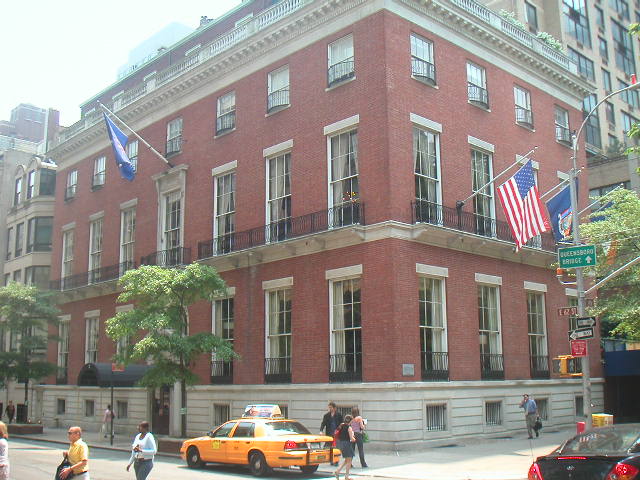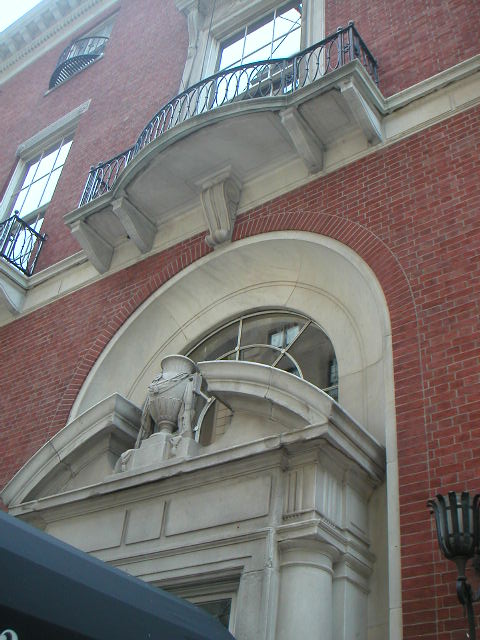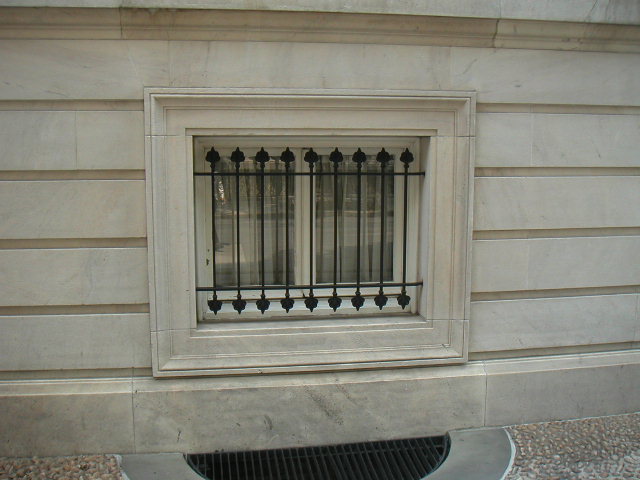 |
New York
Architecture Images-Upper East Side Knickerbocker Club Top Ten New York Clubs |
|
architect |
Delano & Aldrich |
|
location |
2 East 62nd, at Fifth Ave. |
|
date |
1913 |
|
style |
Neo-Georgian |
|
construction |
red brick |
|
type |
Club |
|
images |
 |
 |
|
 |
|
|
Andrew S. Dolkart, "Touring The Upper
East Side, Walks in Five Historic Districts" (published by the New York
Landmarks Conservancy, 1995), |
|
|
-------------------------------------------------------------------------------- The Maine Baseball Club 1898 Americans began playing baseball on informal teams, using local rules, in the early 1800s. By the 1860s, the sport, unrivaled in popularity, was being described as America's "national pastime." Alexander Joy Cartwright (1820-1892) of New York invented the modern baseball field in 1845. Alexander Cartwright and the members of his New York Knickerbocker Base Ball Club, devised the first rules and regulations for the modern game of baseball. Baseball was based on the English game of rounders. Rounders become popular in the United States in the early 19th century, where the game was called "townball", "base", or "baseball". Cartwright formalized the modern rules of baseball. The first recorded baseball game in 1846 when Alexander Cartwright's Knickerbockers lost to the New York Baseball Club. The game was held at the Elysian Fields, in Hoboken, New Jersey. In 1858, the National Association of Base Ball Players, the first organized baseball league was formed. 1845: Alexander Cartwright published a set of baseball rules for the Knickerbocker Club of New York, and his rules were widely adopted. 1869: The Cincinnati Red Stockings became the first openly-salaried team and are thus considered the first professional team. 1871: The first professional baseball league, the National Association of Professional Base Ball Players, was established. 1876: The first major league, the National League, was formed. 1878: Frederick Winthrop Thayer of Massachusetts (captain of the Harvard University Baseball Club) received a patent for a baseball catcher's mask on February 12. The History of Baseball - Alexander Cartwright |
|
|
The American culture before and after the American Revolution did not embody sports into mainstream society. Americans prior to 1850 never engaged in physical conquests that can be properly labeled as sports. Their folk games were far less formal than the organized sports of today. They had unwritten and simple rules to their games. These rules were enforced by custom and the circumstances of the moment. There were no umpires or referees to regulate the game. Rather, the players regulated the games. In early nineteenth century, the emergence of a sporting fraternity created an evolutionary process that would ultimately transform the folk games into the organized sports of modern day. This sporting fraternity, which created the foundation of modern sports, operated outside the mainstream of American culture. These clubs embodied a new form of professionalism, which was frowned upon by mainstream society. Players became professionals of the game. It was not longer merely for the love of the game. The athletic clubs promoted a stricter distinction between playing and spectating roles. The steps that these players and owners took created the type of sports of today. Their efforts helped to fuel the evolution of folk games into spectator centered sports of big business and capital. The beginnings of modern day baseball can be found here prior to 1850. Folk games in their infancy did not have wide spread popularity. They were considered pagan things to do, but many participated none the less. The Protestant religion was an opponent of Baseball. For example in 1621 on the day before Christmas, the governor of the Plymouth Colony, William Bradford, decreed that all able men must be at work. Bradford and his group of protestants, which later became known as the Pilgrims, were religiously devoted to hard work and duty. To them, games were pagan and there was no place for them in society. Thus, Bradford ordered all players off the streets and ordered them to leave. A popular game, which many early Americans played at that time, was stool-ball, which was an antecedent of modern cricket.4 The Protestant temperament inhibited the growth of colonial sports; however, the wealthy class in the eighteenth century began to embody sports as an elite leisure activity. This elite class would create institutions and structures for the game of baseball that would affect the future of sports. The early games were unorganized and played in the streets. There were no exact number of players needed to commence the game. Villagers scheduled games in nearby fields as well. The holidays featured big matches between the residents of two different towns. Baseball had first taken root on this continent in the mid 1700's. Young English boys brought an offshoot of the game of cricket to American shores. Another form of the game much like modern day kick ball was rounders. This too was an antecedent of baseball, and included fielders trying to get an opponent out by belting him with the ball as he ran from base to base. There were many variations of Rounders because it had not official rules. It was usually played according to local custom. This meant that the number of players on a team, the number of bases, the way the bases were laid out, and the distance between them as well as other rules would vary from place to place. Depending upon the custom, the games consisted of running, kicking or throwing the ball. The ball was usually just an inflated animal bladder.5 The games at this time were similar to modern day sports of football and soccer. Most times these games simply turned into a savage brawl. For this reason, many elite Americans who still had strong ties with Victorian England viewed folk games as medieval and savage. Boys and baseball went hand in hand. Boys had played the sport of baseball for centuries on the streets as pick up games. The boys formulated crude rules that governed the play. This child like game eventually evolved into a scientific game of gentlemen and spectators. There were the obvious opponents to folk games, primarily by the Protestants and Victorian culture. These groups of people tried their best to stem the growth of the folk games into greater social events. In 1682, the Quaker Colony of Pennsylvania had an assembly, and they banned all rude and riotous sports as well as imposed heavy fines for violators of the law. Furthermore, in New Netherlands, the Dutch in 1656 outlawed all dancing, playing ball, cards, and cricket on Sunday morning.6 Despite such opponents of play, parents still bought their children balls and dolls, with which to play, and men still congregated to play sporting games. The religious community feared that sports and play would stimulate the passions to such an extent that sex, gambling, dancing, sexual immorality violence would become a fabric of American society. Another opponent to sports was the American government which at the First Continental Congress in 1774 discouraged colonists of partaking in all kinds of gaming, fighting and exhibition. The colonial government at the time was waging war on the mother country of England, and therefore wanted to distance and distinguish its citizens and country as far away from England as possible. Through out the revolution, the sons of liberty attempted to curb all possible sporting activities. Although the majority of society opposed folk games, some supporters did exist. One supporter of sports was John Adams who wrote to his wife, Abigail, that American independence "ought to be solemnized with pomp and parade, with shows, games, sports, guns, bells, bonfires, and illuminations from one end of this continent to the other from this time forward forever more."7
In 1846, Cartwright led this group of men from New York to Hoboken in New Jersey to play one of the first organized games of baseball between two teams before the turn of the century. They played on land donated by John Cox Steven, who was an entrepreneur and a sports promoter.8 The associationknown as the Knickerbockers Club was the first athletic club that focused primarily on baseball.10 They had forty members and all had to pay an annual due of five dollars. Furthermore, the club issued that Mondays and Thursdays were game days. This was the first formal organized baseball club. In order to distinguish themselves from folk games that were unruly and unorganized, the Knickerbocker Club implimented dress code regulations and fined their members for any cursing or vulgar displays. They wanted to present themselves as gentlemen. The early club made baseball a player centered sport. Crowds and the public had no role in baseball yet. The clubs formalized and organized the sport of baseball. This club sparked a revolution in American folk games. Now athletic associations were welcomed in society and men could escape the reality of the nineteenth century and find sanctuary and solitude in the sport of baseball. Baseball in its infancy was not widely popular; however, after the turn of the century, the sport soon became the national game of the United States. The era of sports
prior to 1850 consisted of religious and cultural opposition. The
Puritans and Protestants greatly resented folk games out of fear. A fear
that society would embody the vices of sex, gambling, and violence. With
their ethos of hard work and vigilant duty to god, the religious and
Victorian community failed to realize the importance of these folk games
as a social aspect of American culture. The restrictions and limitations
enforced upon folk games simply fueled the fire and led to the eventual
formation of athletic clubs and associations. These clubs would pave the
way for formal organized sports, and allow them to take root in American
society. The sports revolution was still far away, but the antecedent of
baseball was born in this era and carried into the next.
|
|
|
links |
|